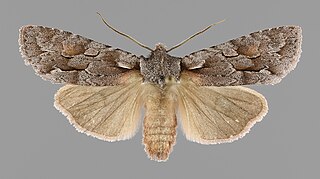
Apamea monoglypha, the dark arches, is a moth of the family Noctuidae. The species was first described by Johann Siegfried Hufnagel in 1766. It is a common, sometimes abundant, European species. It is found in most of Europe except northernmost Fennoscandia and the southern parts of the Iberian Peninsula and Greece. The species is also found in Anatolia, Turkestan, Western Asia and Central Asia, Siberia and Mongolia. In the Alps it is found up to heights of 2,500 meters. The smaller subspecies sardoa is found on Sardinia and Corsica.

Apamea crenata, known as the clouded-bordered brindle, is a moth in the family Noctuidae. It is distributed throughout the Palearctic realm. In the North it crosses the Arctic Circle, in the Mediterranean it is found only in cool locations and mountains avoiding very hot areas. In the Alps, it rises to an altitude of about 2000 metres.

Mesapamea secalis, the common rustic, is a moth of the family Noctuidae. The species was first described by Carl Linnaeus in his 1758 10th edition of Systema Naturae. It is found in Europe, north-west Africa, Turkey and northern Iran.

Lithophane lamda, the nonconformist, is a moth of the family Noctuidae. It is found throughout Europe, except in southern Europe. It is also absent from Iceland and Ireland.
Platynota offuscata is a species of moth of the family Tortricidae. It is found in Guatemala.
Gelechia cuneifera is a moth of the family Gelechiidae. It is found in Mexico (Guerrero).
Gelechia liberata is a moth of the family Gelechiidae. It is found in South Africa.

Kiwaia aerobatis is a moth in the family Gelechiidae. This species was first described by Edward Meyrick in 1924. It is endemic to New Zealand and has been collected at Mount Arthur and at Arthur's Pass. Adults are on the wing in January.
Battaristis ardiophora is a moth of the family Gelechiidae. It was described by Edward Meyrick in 1914. It is found in Guyana, Brazil and Peru.
Aristotelia squamigera is a moth of the family Gelechiidae. It was described by Thomas de Grey, 6th Baron Walsingham, in 1909. It is found in Mexico (Guerrero).
Ornativalva heligmatodes is a moth of the family Gelechiidae. It was described by Walsingham in 1904. It is found in Algeria and Tunisia.
Antaeotricha ptycta is a species of moth of the family Depressariidae. It is found in Guatemala, Panama, Ecuador, the West Indies and Guyana.
Antaeotricha isochyta is a species of moth of the family Depressariidae. It is found in Guyana.
Idiocrates is a monotypic moth genus in the family Depressariidae. Its only species, Idiocrates balanitis, is found in Bolivia. Both the genus and species were first described by Edward Meyrick in 1909.
Antaeotricha hemiscia is a moth in the family Depressariidae. It was described by Lord Walsingham in 1912. It is found in Guatemala.
Antaeotricha admixta is a moth in the family Depressariidae. It was described by Lord Walsingham in 1913. It is found in Mexico (Guerrero).
Antaeotricha encyclia is a species of moth in the family Depressariidae. It was described by Edward Meyrick in 1915. It is found in Colombia.
Catarata stenota is a moth in the family Depressariidae. It was described by Walsingham in 1912. It is found in Guatemala.
Stenoma amphitera is a moth in the family Depressariidae. It was described by Edward Meyrick in 1913. It is found in Peru.
Stenoma consociella is a moth in the family Depressariidae. It was described by Francis Walker in 1864. It is found in Suriname, Guatemala, Panama and Brazil (Amazonas).




